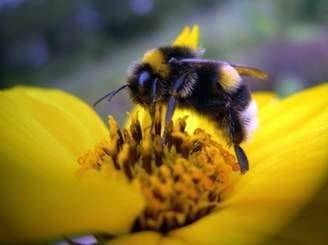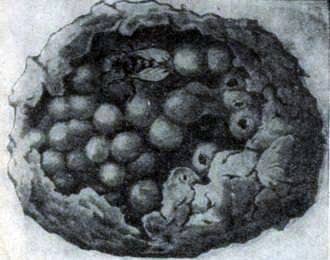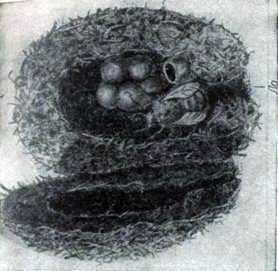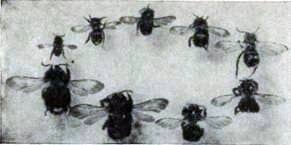
Now let’s talk about bumblebees, insects, which completely completed the transition to a social lifestyle.
Bumblebee State.
Despite its awkward appearance, bumblebees along the external and internal structure have so much in common with bees that in zoology they are ranked among the same family. In their way of life, bumblebees closely adjoin the forms described above and form a link between single and public bees. This may sound strange for those who are familiar with the nests of our bumblebee and its uterus, surrounded by a defensible and diligent family and which can not be called single. But let’s take a closer look.

Fig.111. Underground nest of a stone bumblebee; The waxy envelope of the nest is partially removed so that the honeycomb can be seen. On the right is the uterus. (Decreased by 2/3)
In dense moss on the edge of the forest, between the bush grass in the meadow, in an abandoned mouse hole and other such places, you can find a bumblebee family. The size of the palm, with randomly arranged honeycombs, covered with wax or moss, the bumblebee nest contains from several dozen to several hundred inhabitants.
Armed with the nature of a long proboscis, brushes and baskets, bumblebees, flying from flower to flower, like honey bees, collect nectar and pollen, which are their only food. As a result, bumblebees are considered to be the most important pollinators. To build honeycombs, they use wax, which is extracted from their body, mix it with resin and flower pollen and make of this mass clunky round cells. The economical construction of hexagonal cells is still alien to them. No bumblebee state survives winter in our latitudes. Fertilized in autumn, females spend the winter in hibernation in some shelter, and next year each of them establishes a new family.
In early spring you can see how they are looking for a suitable place for nest on the ground or working on flowers, collecting the first supplies of feed. At this stage, the bumblebee female, like a single bee, can rely only on itself. It makes an elegant small nest, closed on all sides and having only one opening for entry and exit. Inside, she builds round cells for the first baby, and next to it is a pot that resembles a pot-bellied bottle, which, in case of rainy weather, is filled with honey and pollen.

Fig. 112. Young nest of the field bumblebee. The moss sheath is opened and bent. The nest, except the vent, is closed on all sides. The female is one more. In the small cell the first working individuals grow up. On the right is a honey pot. (Real size.)
In the first cell, the female lays about half a dozen eggs and provides them with a supply of honey and pollen. Then the hole is sealed, and later, when the larva grows up, the female again opens the cell and replenishes the food reserves for the growing larvae. But still, the first offspring of bumblebees develops in crowded conditions, and for such a large number of hungry mouths, food reserves are too small. As a result, Bumblebee first-borns are malnourished and grow poorly.
After a certain time, each larva spins the cocoon and turns into a pupa. The economical mother gnaws from the cells now unnecessary wax-building material to use it elsewhere, leaving the cocoons naked. Bumblebees coming out of them are smaller than normal size and due to poor nutrition have underdeveloped ovaries.
So there are working individuals who do not themselves produce offspring, but building cells and taking care of the baby help in this founder of the nest. The latter now becomes a real uterus.
As more new assistants arrive, she is more and more freed from work and soon devotes herself exclusively to the laying of eggs. The honeycomb grows now faster, the cells become more spacious, the feeding of the larvae is more abundant, and therefore the succeeding generations of bumblebees are larger and better developed. So throughout spring and summer, all successive transitional forms are formed from the first underdeveloped insects due to starvation to fully developed females.

Fig. 113. Transitional forms of females of the field bumblebee collected from one nest on September 2, 1935. Along with fully developed females, the uterus of the following year, there were also tiny workers in the nest, which have been preserved since the time of the nest. (Real size.)
Simultaneously with them in summer, and males. They do not participate in domestic work, and fly out swarm in search of young females, with whom they mate in the air. Later in the autumn, the males die out, just like the old female and all the working individuals. The stocks they collected are sufficient only for short periods of unfavorable weather, but not for the long winter, and besides, a light bumblebee nest could not protect the family from frosts. Only fertilized females hide in suitable secluded places and for the next year become uterus.
In the honey bee, working individuals in the structure of their body differ from the uterus by many signs and form their own “caste” (stasis). Auxiliary female bumblebees are just underdeveloped uterus. But one can imagine a simple way of developing a social way of life, in which the emergence – so to speak, due to poor care – of these non-reproductive, but fulfilling all other work female assistants was the first step towards the formation of a real stasis of working individuals.
Consequently, the bumblebee in the spring begins its activity as a single bee. But it is quite similar to a single bee only in the far north, where because of a short summer there is not enough time for the development of many generations. There, the matter generally does not reach the formation of female assistants, and all work on building a nest and caring for brood, just like that of single bees, is performed by the female. It’s good if she manages to rear her offspring in a few warm summer weeks to such a stage to keep her appearance for the next year.
Мелипоны. Плов с медом.
Breeds of bees